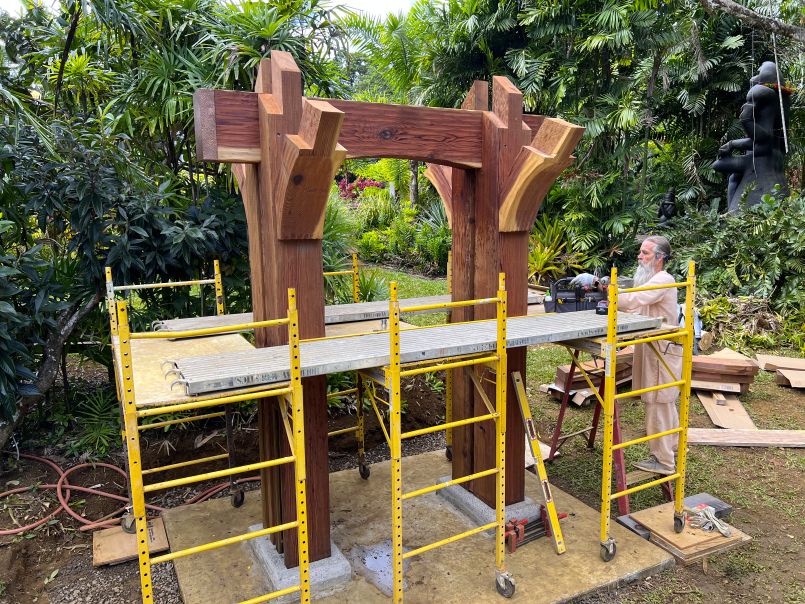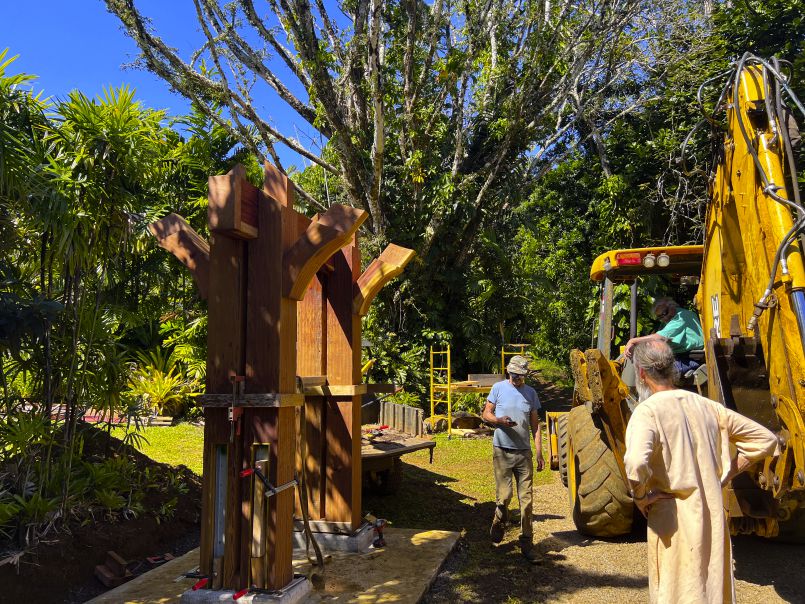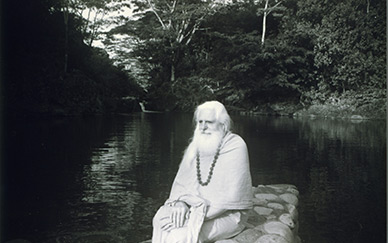Publisher’s Desk – Worship in the Home
Satguru’s latest Publisher’s Desk editorial, from the January/February/March, 2024 issue of Hinduism Today Magazine. Read the full magazine online here.
Granite Bell Tower Installation Part 2

Acharya Kumarnathaswami and Aditya Vinadhara have continued working nearly every day on the meticulous assembly. Today they expect to finish screwing in the wooden roof boards, having waited for more 6-inch stainless steel screws to arrive in the mail. If all goes according to plan, they will hoist the bell into position tomorrow.
Serving the Dharmic Religions #3 – Sikhism
Over the last year, our publications team in Kauai has been quietly working on a sizable side project sponsored by the Uberoi Foundation. The project is intended to assist in the presentation of the four Dharmic faiths, Hinduism, Buddhism, Jainism and Sikhism, as per the foundation's goal. This particular video is meant to teach about the Sikh religion in California 6th grade social studies classes. The Hollywood Sikh Temple was founded in 1969 by Dr. Amarjit Marwah on the 500th Birth Anniversary of Guru Nanak. The present building was completed in 1996. A small group of students visited the gurdwara (House of the Guru) and were asked to remove their shoes, wash their hands and don head coverings. A temple guide then explained the three key principles of the Sikh faith: Remember God in everything you do, share with others before you share with yourself and earn an honest living by being honest. The students were given an overview of the origins and beliefs of the Sikh faith as they toured the temple.
Directed by Mainak Dhar, Produced by Gabriel Bruskoff.
Many Forms of Siva
Gurudeva would often tell us that "Siva is coming today, in some of His many forms." He saw each visitor as Siva in yet another form.
Today we share some of Siva's forms. Visitors from Canada and a local group called the Master Gardeners of Kauai.
One of the Master Gardeners recorded some of the stories shared by Sadasivanathaswami. It's a bit long, 32 minutes, but has some interesting insights into the magic land Gurudeva created. Here is the link:
https://www.youtube.com/watch?v=C9v4xBAb5A8
The Evolution of Consciousness, Part One
Satguru Bodhinatha Veylanswami gives his weekly upadesha in Kadavul Temple at Kauai’s Hindu Monastery in Hawaii. It is part of a series of talks elaborating on the inspired teachings of Satguru Śivaya Subramuniyaswami as found in his book Merging With Śiva.
"In mystic cosmology, the seven lokas, or upper worlds, correspond to the seven higher chakras. The seven talas, or lower worlds, correspond to the chakras below the base of the spine. Man is thus a microcosm of the universe, or macrocosm. The spine is the axis of his being, as Mount Meru is the axis of the world, and the fourteen chakras are portals into the fourteen worlds, or regions of consciousness. The actinodic life force within the sushumṇā current runs up and down the spine and becomes very powerful when the iḍā and piṅgalā, or the odic forces, are balanced. Then man becomes completely actinodic. He doesn’t feel, in a sense, that he has a body at that particular time. He feels he is just a being suspended in space, and during those times his anāhata and viśuddha chakras are spinning and vibrating. When, through the practice of very intense, sustained states of contemplation, he merges into pure states of superconsciousness, the iḍā and the piṅgalā form a circle. They meet, and the pituitary and the pineal glands at the top of the head also merge their energies. This produces deep samādhi."
Serving the Dharmic Religions #2 – Jainism
Over the last year, our publications team in Kauai has been quietly working on a sizable side project sponsored by the Uberoi Foundation. The project is intended to assist in the presentation of the four Dharmic faiths, Hinduism, Buddhism, Jainism and Sikhism, as per the foundation's goal. This particular video is meant to teach the Jain religion in California 6th grade social studies classes. The Jain Center of Southern California (JCSC) located in Buena Park, California, is a non-profit religious organization to pursue a goal of practicing, promoting and preserving the Jain religion. Started in 1979, the present center of 13,000 sq. ft. was opened in 2008 to accommodate the growing Jain population. The exterior design of the center is inspired and reminiscent of ancient Jain temples of Delwada, Ranakpur and Paliana Tirths. Carved Jesalmer yellow limestone was designed and produced in India for the exterior of the building, and the interior uses natural stone including white marble and colorful granite. Each video will allow students to experience these temples as a digital school tour, when visiting them in person might not be possible.
Directed by Mainak Dhar, Produced by Gabriel Bruskoff.
Hibiscus Transplanting
Out near Hanuman and the rudraksha grove lies a huge pile of dirt brought in by the state project due to widening the main road. We are hoping their team can push the dirt south into the pasture so we have room to work on the parking lot preparations. There is a berm behind this pile with 200 feet of hibiscus planted, so we spent two mornings to transplant nearly 70 plants to another location near the monastery main buildings. Now the space is cleared for the dirt pile to be moved over.
Granite Bell Tower Installation – Part 1

Jai Ganesha!
Over the last few days we've seen the first major steps of the installation of the Redwood Granite Bell Tower that is being built near Iraivan Temple's Temple Builder's Pavilion. For over a year, this hand-carved masterpiece has been in the works as a side project of the Ganapati Kulam and under the oversight of Acharya Kumarnathaswami, who has done most of the woodworking himself.
For those that don't know, this tower hangs a granite bell that was carved on the same stone of Iraivan Temple. When struck with a wooden mallet, it produces a unique evanescence that only reverberating stone could make.
Rudrakshas Arrive from Nepal

Nepal is the major supplier of Rudraksha beads to the world, and we did a feature story about that in Hinduism Today last fall. The story was told by journalist and photographer Nikki Tapar, who flew to the valley where most of the trees are grown to discover the amazing details for the feature article. For instance, did you know that the sale of the beads represents fully 6% of the nation's Gross National Product? Or that a single bead sold at auction for $84,000?
Since we have the West's only Rudraksha Forest here at the monastery, we have a special interest in the trees and their fruits. Nikki sent us some Nepalese beads, and we discovered they are different than ours, lighter in color and somewhat more detailed in texture.
So, we commissioned Nikki to acquire seedlings. She flew back to the valley and bought 16 saplings, about 3 feet tall, carrying them back to her home in Kathmandu. She and Sadasivanathaswami went through some months of permitting, planning, and preparing the trees for the flight to Kauai.
They arrived at the monastery yesterday, and the box was unpacked. The tall saplings had been pruned short for the shipping, but we are assured they will recover soon and in about 4 years, we will have our first harvest of these special botanical gems. And make them available in the MiniMela.
At the end of the slideshow, there is a QR Code leading to the full magazine article.
Thank you, Nikki, for your amazing help (and tenacity) with this international exchange of DNA.
Spinning Wheels of Consciousness, Part Four
Satguru Bodhinatha Veylanswami gives his weekly upadesha in Kadavul Temple at Kauai’s Hindu Monastery in Hawaii. It is part of a series of talks elaborating on the inspired teachings of Satguru Śivaya Subramuniyaswami as found in his book Merging With Śiva.
"The same cyclical pattern of development in human history is evident even more clearly in the growth of the individual. In the seven cycles of a man’s life, beginning at the time of his birth, his awareness automatically flows through one of these chakras and then the next one, then the next and then the next, provided he lives a pure life, following Sanātana Dharma under the guidance of a satguru. ¶In reality, most people never make it into the higher four chakras, but instead regress back time and again into the chakras of reason, instinctive will, memory, anger, fear and jealousy. Nevertheless, the natural, ideal pattern is as follows. From one to seven years of age man is in the mūlādhāra chakra. He is learning the basics of movement, language and society—absorbing it all into an active memory. The patterns of his subconscious are established primarily in these early years. From seven to fourteen he is in the svādhishṭhāna chakra. He reasons, questions and asks, “Why? Why? Why?” He wants to know how things work. He refines his ability to think for himself. Between fourteen and twenty-one he comes into his willpower. He does not want to be told what to do by anyone. His personality gets strong, his likes and dislikes solidify. He is on his way now, an individual answerable to no one. Generally, about this time he wants to run away from home and express himself. From twenty-one to twenty-eight he begins assuming responsibilities and gaining a new perspective of himself and the world. Theoretically, he should be in anāhata, the chakra of cognition, but a lot of people never make it. They are still in the bull-in-the-china-shop consciousness, crashing their way through the world in the expression of will, asking why, reasoning things out and recording it in memory patterns which they go over year after year after year."
From Our Gurus' Teachings
Archives are now available through 2001. Light colored days have no posts. 1998-2001 coming later.

